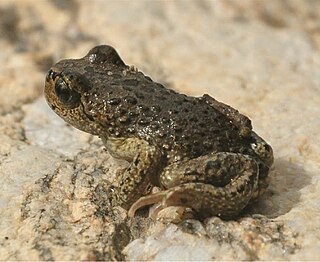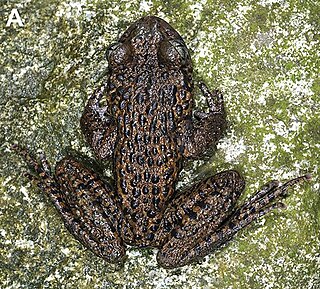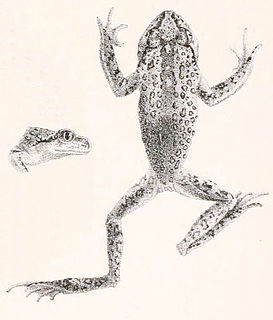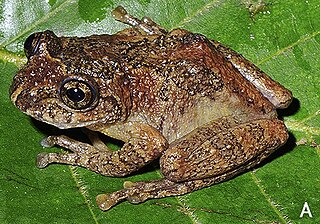
Salamandridae is a family of salamanders consisting of true salamanders and newts. Salamandrids are distinguished from other salamanders by the lack of rib or costal grooves along the sides of their bodies and by their rough skin. Their skin is very granular because of the number of poison glands. They also lack nasolabial grooves. Most species of Salamandridae have moveable eyelids but lack lacrimal glands.
Atympanophrys is a genus of frogs in the family Megophryidae. They range from central China south to northern Vietnam. They are commonly known as hidden-tympanum horned toads.

Leptobrachella is a genus of frogs in the family Megophryidae. Members of Leptobrachella are found throughout Asia including on Borneo and the Natuna Islands. They are sometimes referred to as Borneo frogs, slender-armed frogs, or dwarf litter frogs. The genus contains over 80 species with 25 found in China alone.

Eastern spadefoot toads comprise a genus of the family Megophryidae in the order Anura, and are found in southern China, northeast India, southeast Asia, and islands of the Sunda Shelf as well as the Philippines. They are characterized by a stocky body with slender, short hindlimbs. In identifying species, iris colour is a valuable diagnostic morphological characteristic ; the iris has uniform colour in some species, whereas in other species the upper half is coloured and the lower half is dark.

Leptolalax is a genus of frogs in the family Megophryidae. They are sometimes known as Asian toads, metacarpal-tubercled toads, or slender litter frogs, although many species-specific common names do not follow these conventions, and many species do not have common names. They are widely distributed in southeastern and eastern Asia, from southern China and northeastern India to the Malay Peninsula and Borneo. Leptolalax are typically small and have a cryptic colour pattern and no obvious morphological characters useful in systematic studies. Consequently, both molecular genetic analyses and analysis of advertisement calls by male frogs have been important in identifying new species.

Scutiger boulengeri is a species of toad in the family Bufonidae. It is found in Nepal, India (Sikkim) and western China. A healthy population has been found at an elevation of 5,270 m (17,290 ft) in one of the lakes in the Gurudongmar Lake complex in Sikkimese Himalaya. This is one of the highest elevations where amphibians have ever been recorded.
Scutiger nyingchiensis is a species of toad found in the Himalayas of southeastern Tibet (China), northwestern Nepal, and tentatively, Bhutan. There are no confirmed records from India; earlier records refer to Scutiger occidentalis or Scutiger spinosus. Its type locality is Nyingchi, Tibet. It is also known as the Nyingchi high altitude toad, Nyingchi alpine toad, or Nyingchi lazy toad.

Scutiger sikimmensis is a species of toad in the family Bufonidae. It is found in northeastern India, Nepal, Bhutan, and Tibet. Many common names have been coined for this species: Sikkim lazy toad, Sikimmese pelobatid toad, Sikkim high altitude toad, Sikkim spade foot frog, Blyth's short-limbed frog, and Sikkim snow toad. It is very common in the high altitudes of Sikkimese Himalaya.

Paramesotriton, also known as warty newts or Asian warty newts, is a genus of salamanders in the family Salamandridae. The genus is found in southwestern and southern China and in northern Vietnam. Most of the species are endemic to China, and the majority of them have been described recently, since 2008. The genus includes both pond and stream dwellers.

Oreolalax is a genus of amphibian in the family Megophryidae. They are mostly endemic to southwestern China, with one species in northern Vietnam, and possibly extending into adjacent Laos. There is also a population in Arunachal Pradesh that has not yet been assigned to a species, although it might rather be a Scutiger.

Scutiger is a genus of toads in the family Megophryidae. Common name lazy toads has been coined for them. They occur in China, Burma, Nepal, and northern India in high-altitude habitats. Most are endemic to China.
Scutiger mammatus is a species of frog in the family Megophryidae. It is endemic to Western China and known from eastern Tibet, southeastern Qinghai, western Sichuan, and northwestern Yunnan.

Xenophrys is a genus of amphibians in the family Megophryidae. They are found in southeastern Asia to Borneo. Their common name is strange-horned toads.

Nasutixalus jerdonii is a species of frog in the family Rhacophoridae. It is found in the northeastern India, in the West Bengal, Nagaland, Manipur, and Meghalaya states. It range might extend into the adjacent Nepal. The specific name jerdonii honours Thomas C. Jerdon, an English herpetologist. Common names Jerdon's bubble-nest frog, Jerdon's tree frog, and Jerdon's bush frog have been coined for this species.

Scutiger spinosus is a species of toad in the family Megophryidae. It is found in Medog County, Tibet (China) and in Tawang district, Arunachal Pradesh (India). Prior to its description in 2016, it was confused with Scutiger nyingchiensis. Common name spiny lazy toad has been coined for it.

Nasutixalus is a genus of frogs in the family Rhacophoridae. The genus is found in northeastern India and adjacent southeastern Tibet as well as western Yunnan (China); the range might extend into the adjacent Nepal and Myanmar. Common name ridged-nose treefrogs has been coined for this genus.

Diploderma is a genus of lizards in the family Agamidae. Species of Diploderma are native to Myanmar, China, Vietnam, Taiwan, and Japan. Most of the species are found in China, including many endemics.

Oreolalax longmenmontis is a species of frog in the family Megophryidae. It is endemic to Sichuan, China, and is only known from its type locality in the White River National Nature Reserve, Pengzhou City. The type locality is in the central part of the Longmen Mountains. Accordingly, common name Longmen Mountains toothed toad has been proposed for this species.
Scutiger ghunsa is a species of toad in the family Bufonidae. It is endemic to eastern Nepal and only known from its eponymous type locality, Ghunsa, in the Taplejung District. This species is also known as Ghunsa alpine toad and Ghunsa high altitude toad. Its closest relatives are Scutiger nepalensis and Scutiger sikimmensis.

Leptobrachella suiyangensis, also known as Suiyang leaf-litter toad, is a species of frog in the family Megophryidae. It is endemic to Guizhou province in southern China and so far only known from Huoqiuba Nature Reserve, its type locality in the eponymous Suiyang County.














